If you’ve worked professionally as a graphic designer or are just starting out you may be familiar with freelance work. As working trends are shifting and prices are rising many people have started to look for work online – even graphic designers.
Becoming a freelance graphic designer can be confusing, difficult and complicated if you don’t know where to start. But, I’ve seen people of all ages, some even above 50, who’ve started freelance graphic design after being in this field for many years.
Being a freelance designer can be liberating. You can be your own boss, decide your own deadlines and work on various projects with different clients. However, before you start freelancing, you need to learn graphic design first.
You can enroll in a course, study online or read a few books to get an idea of the basics of graphic design, its design principles and rules. Although a graphic design degree will put you ahead of the crowd, you can also be a successful self-taught graphic designer.
I’m pretty confident that after reading through and applying these tips step by step you’ll be on your way to becoming a successful freelance graphic designer.
Preparing to Become a Freelance Graphic Designer
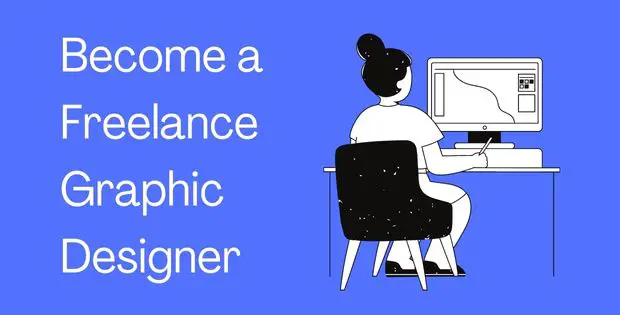
You have two options when it comes to becoming a freelance graphic designer. You could either work as a self-employed individual or start your own graphic design agency. When starting out I’d suggest you be self-employed and get the feel of the whole freelancing landscape. This way you’ll be better equipped to run your own agency.
It’s also much more freeing. You are your own boss and can work remotely from the comfort of your own home. And since you aren’t managing anybody yet you also won’t be having the stress of revising or supervising other people’s work.
So, what should you know before you dive into freelancing? Here are some things you should first consider when going down this path.
Choose a Niche to Specialize In
Graphic design is a competitive field due to the growing demand of graphic designers. The barriers to entry for graphic designing is also low with many people claiming to be “professional” graphic designers.
Tools such as Canva and Desygner have also made graphic designing a saturated field. Many people believe that just because they have these tools they’re just as good as any designer. But, there are many issues with Canva which paves the path for passionate graphic designers to excel in this field.
Before you proceed, you need to choose a niche to specialize in so you can stand out. Being a generalist is one of the main reasons many graphic designers are paid low nowadays. You could always extend your services to other fields but when starting out you absolutely have to choose a niche to specialize in.
How to Choose a Graphic Design Niche?
Choosing a niche can be a confusing process for any designer. We’re creative people and we want to share all our talents with the world. But in freelancing, people who specialize in a field are seen as experts which makes them trustworthy, reliable, and higher paid.
Here are some tips to choose your graphic designing niche:
- When finding your niche the first place to look is your own personal taste. Do you have an expressive/playful style of working or do you steer towards a luxurious style?
- Choose a specific field of work e.g. logo design, web design, album cover design etc.
- Work with a specific type of client such as corporate businesses, local bakeries or social media influencers etc.
- Whatever niche you choose, make sure it’s profitable. You might think designing business cards is a good idea but many people won’t be ready to pay hundreds of dollars for a business card design.
- Make sure the niche you choose isn’t too broad (e.g. logo design) but isn’t too narrow as well (e.g. logo designing for business owners impacted by natural disasters). Choose a niche that is in the middle and which you can extend on later like logo designing for fast food restaurants.
Create Your Personal Brand
Once you have your niche decided it’s time to figure out how you want to be seen by your clients. When working as a freelancer your personal profile is the most crucial aspect of your online career. It’s what distinguishes you from the other thousands of designers offering similar services.
How you portray yourself online will ultimately affect the kind of clients you get. For example, you’ll often see jewelry stores with a golden colored logo and a stylish font. Why? Because they want to be known for the luxury they offer. If they had a colorful logo with a playful font it wouldn’t give the same effect and would have people confused on what the shop sells.
To start creating your personal brand you need to:
- Make a logo or take a high-quality photo of yourself
- Decide on the kind of design aesthetic you’ll be going for
- Choose the kind of fonts and colors you’ll be using to represent your brand (make sure you have a reason for choosing a specific font or color rather than just relying on your gut feeling)
- Write a description stating what you do, your specialization and why people should contact you specifically
We’ll discuss how to build an online presence in further detail below.
Create a Comfortable Workspace
When working in freelance, one of the main benefits people seem to enjoy is working from home. But, at home there are many distractions which can negatively impact your productivity as a freelancer.
Kids running around, friends messaging you, family members commuting etc. All this calls for a comfortable working space where you can work peacefully. Here are some tips to creating a comfortable workspace for maximum productivity:
- Have a separate room for your work. This can be an empty store room or a spare guest room. Move your desk, chair and computer there so that you get in the working zone
- Make sure your room is far away from any extra screens such as a TV or gaming console (I can feel my PS4 breathing on me as I write this)
- Create a schedule and set a time where you’re expected to work
- Before starting to work, inform your family members that you’re working and to not disturb you
- When working, turn off your mobile phone. This may not be possible for everyone as there may be important calls or messages you need to receive. Another alternative is to turn-off unnecessary notifications such as social media alerts, E-mails, and Google Discover
- Set time slots where you’re allowed to take breaks, check your phone and email or just get up and go for a walk
- Be sure to have all the necessary equipment for your workspace. You can check out my guide on setting up your graphic design office but even if you just have a chair, laptop and a big water bottle by your side – you’re probably all set to go.
Marketing Yourself

Now that you have your workplace set up you’re ready to start freelancing! Most beginners struggle here as they don’t really know where to start. Since many aspiring designers are focused on getting their designs right they forget one essential aspect to their freelancing success – effectively marketing yourself.
There are multiple ways to market yourself: social media, personal website, freelance marketplaces etc. I’ll walk you through them but you’ll have to experiment a bit with every platform and see which one you’re most comfortable with.
I’ll be going through building a website and freelance marketplaces (I discuss Upwork later in this article) as these in my opinion are the best ways to start freelancing.
How to Create a Website to Market Yourself
Most professional graphic designers would prefer having a website. A website gives you your own personal portfolio which you can build upon and enable your clients to directly contact you.
It’s the ideal way to market your graphic design skills online. To get started, you’ll have to first get a few things:
- A domain (the name of your website)
- Web hosting
- A capable content management system (CMS)
For the domain you have multiple options but the most common are Hostgator, GoDaddy and Domain.com. Bluehost offers great web hosting at affordable prices and for the CMS your best bet is creating a site with WordPress.
I won’t go into too much detail as there’s a lot that goes into building a site. You can check out the video below to see how to setup your website from scratch (it’s a pretty long video so better grab a few snacks):
Once you have your website ready you can start building your portfolio.
Create a Solid Design Portfolio
Your portfolio is the bread and butter of your freelance profile. Without a portfolio you won’t be getting any clients. So, making a portfolio is important. For most beginner designers the problem is that they haven’t done any work yet to showcase their portfolio.
When starting out there are a few ways you can build your portfolio without doing client work:
- Join design contests on 99designs or Freelancer
- Volunteer to design for charities or non-profit organizations
- Think of an imaginary brief and design based on that
- Create fan art or concepts of famous brands/influencers on social media
- Take on free or contributory projects to fill up your portfolio
Remember you don’t need to be an expert when first starting out. Keep in mind you’re just a beginner and your portfolio will start to shine overtime.
If you’re working in wordpress you have the convenience to select a portfolio theme to showcase your work effectively. But, a portfolio isn’t all about showing your best work. It’s also about showing who you are and what you do.
When creating your website there are other pages you need to consider adding. These are:
- Homepage
- About Us
- Services
- Contact Us
These are the basic pages every website needs to provide some structure. You can look at other prtfolios to get some inspiration. Maria Marie’s portfolio is a great example of beauty and professionalism:
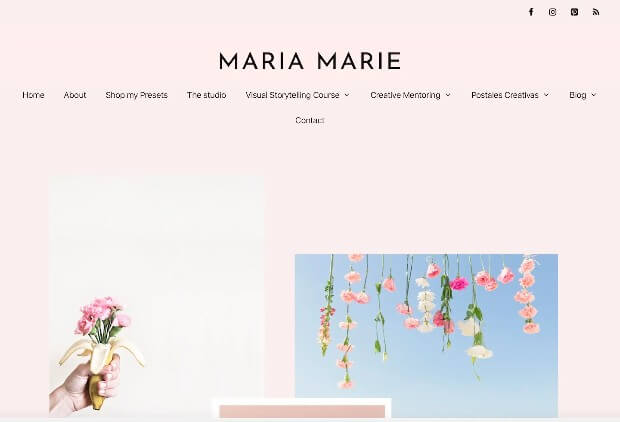
If you want to learn more about creating a graphic design portfolio you can check out my in-depth guide on making a graphic design portfolio from scratch.
Finding Clients
When you’ve set up your website and/or registered yourself on a freelance platform it’s time to find clients. This is probably the most exhaustive part of freelancing as it can take a lot of time to find clients.
A good place to start finding clients is through freelance marketplaces. If you don’t have a portfolio you’re proud of I suggest you start with Instagram or LinkedIn. Create a professional account on social media and DM people to get some work.
However before you go and start spamming people for work you need to build your online presence.
Build Your Online Presence
When it comes to building your online reputation what you’re essentially doing is trying to get recognized. It might seem overwhelming at first, especially if you’re a bit socially anxious like me, but you’ll gradually see people come to you.
Building your online presence takes time but it’s also the most sustainable way to grow as a freelancer. There are several steps you can take to start but here’s what I’ve seen work most of the time:
Create Concept Art
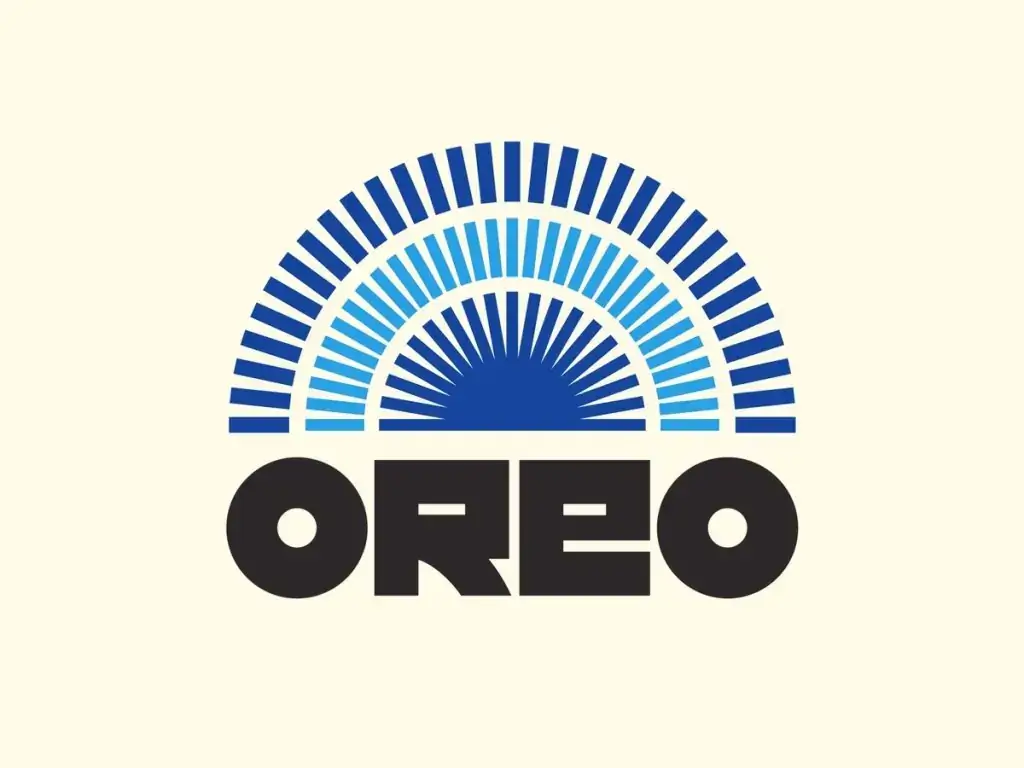
You’re a graphic designer but you’re the only one who knows it yet. A great way to start gaining traction on social media is to create concept art and share it on social media. This can be a great way to blend in with other designers who are looking for inspiration, ideas and a dose of creativity.
Redesign a logo in your own style, create a poster for the latest iPhone launch, make a short film on McDonald’s. Experiment with different brands and redesign some concepts, share them on your social media wall and tag them.
Here’s a video from Seso, a popular graphic designer on YouTube, who walks through the exact steps he took to find design clients from Twitter. Notice how he first built up his portfolio by making concepts for other influencers, got recognized and then clients started coming to him. All from scratch!
Engage in Social Media Groups
For me the most successful way of getting clients has been to engage in groups. And by engage I mean interacting with others. There are multiple groups you can get into but the most common are Reddit and Facebook.
Both these platforms have dedicated groups for graphic design, animation, digital art etc. Personally, I’ll go with Reddit as it is better moderated than most Facebook Groups. But you should dabble with both and decide which one is better.
I’d suggest you join only 1 or 2 groups max to truly be part of the community. No matter how much you try you’ll never be able to remain active in like 5 or 10 groups at a time (trust me, I’ve tried it).
Once in these groups engage in discussions, help people, ask questions and share your work. Remember your objective isn’t to grab clients, it’s to build your online presence. Yes, it takes time (took me 1-2 years for my first clients) but it’ll be worth it as you won’t have to worry about not having work in the long-run.
Share Things Other Than Your Artwork
The best thing about these groups is that it’s a place where you can casually talk and share things with others. You don’t necessarily have to share your best work as you would in your portfolio. Rather share some behind the scenes clips, experiences with your clients, and what supplies you use.
This way you’ll build a bit more transparency. People will actually want to know more about you as a person rather than think of you as just a desperate designer begging people for work.
Update Your Portfolio
If you apply the tips above, there’s no doubt your portfolio will start to fill up. But, your portfolio should only feature your best work rather than all your work. So once you have a few designs to show, arrange them in a way you see best and showcase the ones you’re most proud of.
Keeping your portfolio updated is important. When you start out as a beginner with no experience most clients would avoid you. But if you start gaining experience you need to keep prospects notified by updating your portfolio regularly.
Most designers might discover their own personal style and change their website accordingly. Some might update their social media wall to match their aesthetic. But the most crucial is keeping your Contact and About info updated. Make sure you’re still not showing “beginner” on your portfolio although you may have gained a lot of experience since then.
Setting Your Rates
As a beginner freelance graphic designer it can be difficult to figure out your rate. You don’t want to charge too high to scare away clients nor do you want to undervalue your work. There are usually two pricing models to set your rates.
- Hourly rate
- Fixed rate
The average hourly rate a freelancer would charge is around $20-30 per hour. As designers gain more experience they usually increase their rate to $40-50. I’ll get into both pricing models briefly.
Charging by the Hour
Most designers tend to make the mistake of charging only for the time taken to design the actual logo. However, there are many stages in the design process which require time and effort. These include:
- Research
- Brainstorming
- Concept
- Presentation
- Revisions
- Final Design
By factoring in the above you can better estimate what to charge your clients.
Fixed Pricing
Fixed pricing is a lot more simple. You and your client agree on a fixed price for the project regardless of how long it takes you. Designers also charge extra for add-ons like printing materials and revisions.
Charging a fixed price to your clients can be difficult to figure out as you don’t have an idea of what to charge. Sure, if the project seems complex you might charge a higher rate, but exactly how high should you go?
Since these pricing models are a bit abstract, I prefer using the value-based pricing model. I learned this method from the Futur, and you can see the CEO, Chris Do, explain it in this video below:
Value-based pricing is calculated by factoring in the long-term value you provide the client rather than the cost of the design itself.
Value-based pricing means you price the client and not the project
Chris Do
However, I’ve seen this work best mostly for pricing logo designs rather than general graphic design work. It’s also a tactic mostly used by design agencies or experienced freelance graphic designers.
When starting out I’d suggest you start with a beginner’s hourly rate and then move on to value-based pricing (if you feel the need to.)
Getting Paid

After a long day’s work and a couple hundred revisions it’s time to get paid! Getting paid online is a smooth, stress-free process. If you’re in the US you need to have a PayPal account as it is the most common and efficient form of payment.
If you’re outside the US you can use other alternatives such as local bank transfer or Payoneer.
Although you could ask for payment directly it would be better to create a professional invoice and send it to your clients.
Creating and Sending Invoices
When it comes to showing their creative side, graphic designers can spew limitless ideas. But, when it comes to creating invoices it’s common for designers to start scratching their head.
Invoicing may vary from client to client. This video from TheBuffNerds provides a detailed guide on how to properly invoice your clients.
Managing your invoices is also something to consider. You can check out our article on some common freelance invoice terms if you’re confused about creating an invoice.
Getting Started on Upwork
Once you start earning a bit of money on other platforms, it’s time to get on Upwork. Although you can continue working on your website and social media platforms, getting on Upwork will help you excel your professional freelance career.
You also have Fiverr but UpWork is the best platform for freelance graphic designers as it is much more professional. On Fiverr the barriers to entry are low making it extremely competitive.
On UpWork, your account goes through an approval process and you need to have a professional looking profile in order to start working.
So, I’ll go through how to market yourself on UpWork.
Registering Yourself on Upwork
To register yourself on Upwork follow the below steps:
1. Go to Upwork and click on Sign Up
2. Select “I’m a freelancer looking for work” and click Create Account
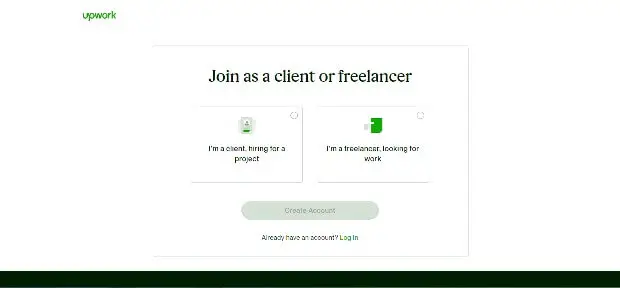
3. Next, create an account. You can create a new account or sign in with your Gmail or Apple ID and click on create account
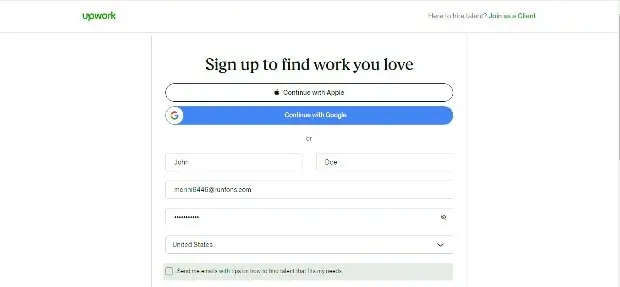
4. After creating your account you’ll get a verification email. Verify your account and you’ll be redirected to set up your account
Setting up Your Account
After getting your account made you have to now make it look professional. You’ll be prompted by Upwork to follow a few steps/answer some questions. After answering the questions you’ll be greeted with this screen:
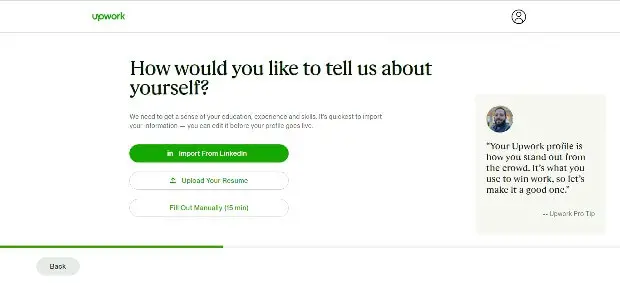
To make things easier you can upload your resume through a PDF or import it directly from LinkedIn. Upwork does a great job of recognizing your details so you’d just have to slightly go through it and revise a bit.
You can also fill it out manually which can be time-consuming. Although it might be a bit tedious you should take your time when filling it out.
This is going to represent your profile as it includes everything. Your skills, experience, interests, hobbies, accolades etc. Make sure to fill them out properly and avoid making spelling mistakes.
Check out my guide on creating your graphic design resume for tips on making the perfect resume
Sending Proposals
On Upwork you are given access to a job board where you apply for jobs relevant to your position. From the job board you find jobs and send a proposal. To send a proposal you get “connects” which you use to apply for jobs.
When applying, read the requirements thoroughly and send proposals to jobs you think you’d be suitable for you. As a beginner, try to apply for 3-5 jobs daily, and make sure to use all your connects for the month. These will get refilled next month.
Getting Paid on Upwork
Once you get a job on Upwork getting paid is the easy part. Since Upwork is an established and trusted freelance marketplace they ensure that payments are sent and received securely at the proper time.
Upwork provides multiple payment methods including:
- U.S. Bank Transfer
- Local Bank Transfer (Outside U.S.)
- Wire Transfer
- Instant Pay for Freelancers (U.S. only)
- PayPal
- Payoneer
- M-Pesa (Kenya only)
You can read Upwork’s Manage How You Get Paid article to find out what the process is exactly like.
Common Pitfalls to Avoid
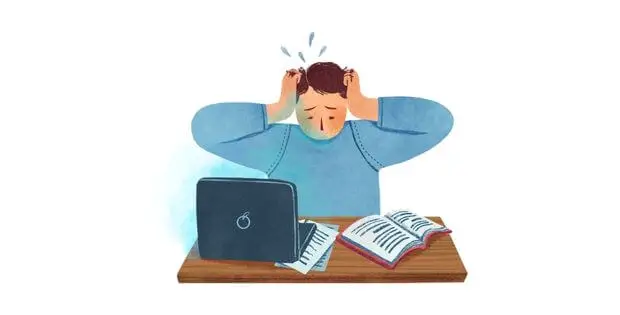
You’re well on your way to becoming a freelance graphic designer. However, the nature of online work can be tricky and not being aware can get you into all kinds of troubles.
Here are some common issues freelancers go through and how to avoid them.
Working for Free
Starting out is the most difficult part of freelancing as a graphic designer. Many people will try to take advantage of your desperation and encourage you to work for free. Graphic designers are told to work for exposure but in reality by working with these clients you won’t be getting any exposure.
If Coca Cola wants you to design a poster for them for free – yeah I guess that could give you some exposure. But mostly these people are just freeloaders manipulating you, getting you to work for them for free.
Best way to deal with such clients is discussing payment in the start before going into too much detail about the project. If they agree to pay, continue, if not, leave them.
Not Taking Advance Payment
Not getting paid in advance is a gateway for people to easily scam you. Asking for advance payment ensures two things. Firstly, that the client is genuine and he’s not planning on scamming you or running off with your work. Second, that you’ll be compensated for your time.
Always make sure to take advance payment. This could be 20% or 50% of the total payment. If you’re working on freelance platforms such as Upwork or Fiverr, you don’t need to take advance. Payments here are handled by the platforms themselves so there’s no need to worry about not getting paid most of the time.
Not Saving Up Money
The nature of freelance work is dynamic and work can fluctuate. This means you’ll sometimes find yourself busy with dozens of clients and other times you’ll struggle to find a single project.
These ups and downs are normal in freelancing so the best way to cope when things are going slow is to save up. Save enough money to cover your basic expenses and if possible have an emergency fund to stay on top of your expenses.
An emergency fund can be the minimum amount of money you plan on saving. This money should be in your account at all times and shouldn’t be spent on things like shopping, eating out or subscription services.
For me, I tend to keep at least $200-300 saved up as my emergency fund. Any money on top of that is extra savings.
Failing to Regularly Update Your Portfolio
Many freelance designers are excited to get their first few clients which makes them take their portfolio for granted. Your portfolio is the most crucial aspect of your freelance career. It is the proof of your work and your identity as a graphic designer.
As you start growing your career, gaining more experience, and making more artwork you’ll need to update your portfolio. Consistently updating your portfolio will keep potential clients in the know of how you’re progressing and some of the brands/clients you’ve worked with.
Maintaining a Healthy Work-Life Balance
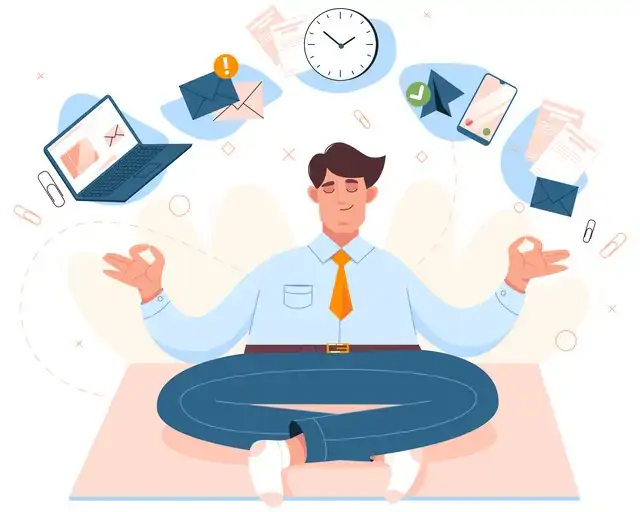
Having your personal life separate from your work life is important. When you’re working from home it can be difficult to be able to distinguish the difference between the two. That’s why it’s important to set some boundaries early on so you can maintain a positive work-life balance.
- Establish working hours – you shouldn’t be working all day nor should you work just a few minutes. Set your start and end times of when you should be working and try not to work more than 8 hours a day.
- Manage your time – having a proper schedule and tracking your time will help you manage your work better. Manage your time in a way you’re available to cater to your personal needs and complete your work on time as well.
- Have a separate room – having a separate room will help you keep your work life limited to one room and not overtake your personal life
- Learn to say no – as a fresher you should take on most projects that come your way to build your client base. However, once you gain experience you’ll be able to better judge which projects you should take. You don’t necessarily have to take on every project so refuse the ones you think would disrupt your work-life balance.
Conclusion
Reading this guide should give you a good idea of how to become a freelance graphic designer. Being a freelance designer may be the ideal path for some. You set your own schedule, choose where you want to work from and take on multiple different projects.
However, working online can be a bit confusing and this guide is a good starting point to start your freelance career.
This Article is Good and very informative but you missed some points in article such as:
1.Continuous Learning and Adaptability
2.Time Management and Organization
I have also write article on this topic and I have insert all main points in article
if you want to read click this!
https://brightwithus.com/10-skills-you-need-to-become-a-freelance-graphic-designer/
Those are some good points. Thanks for the input